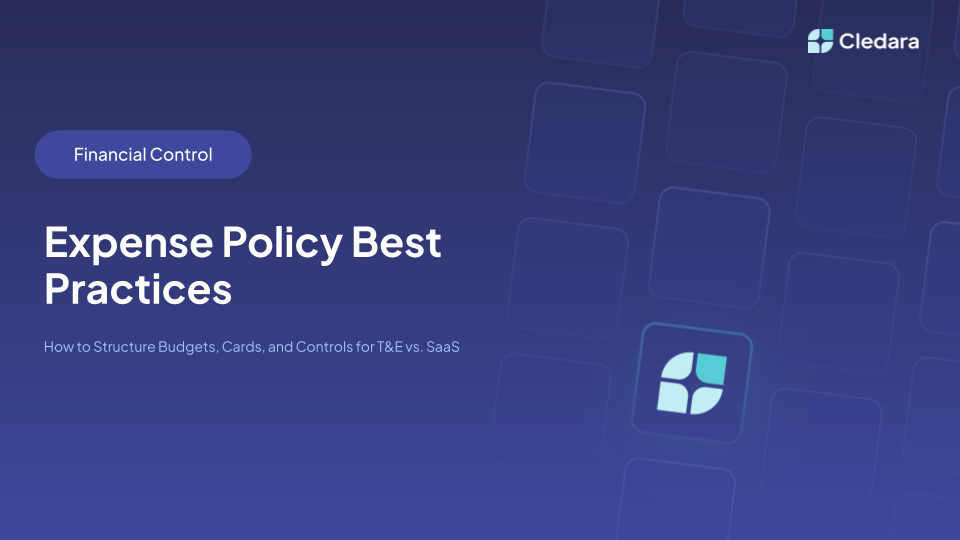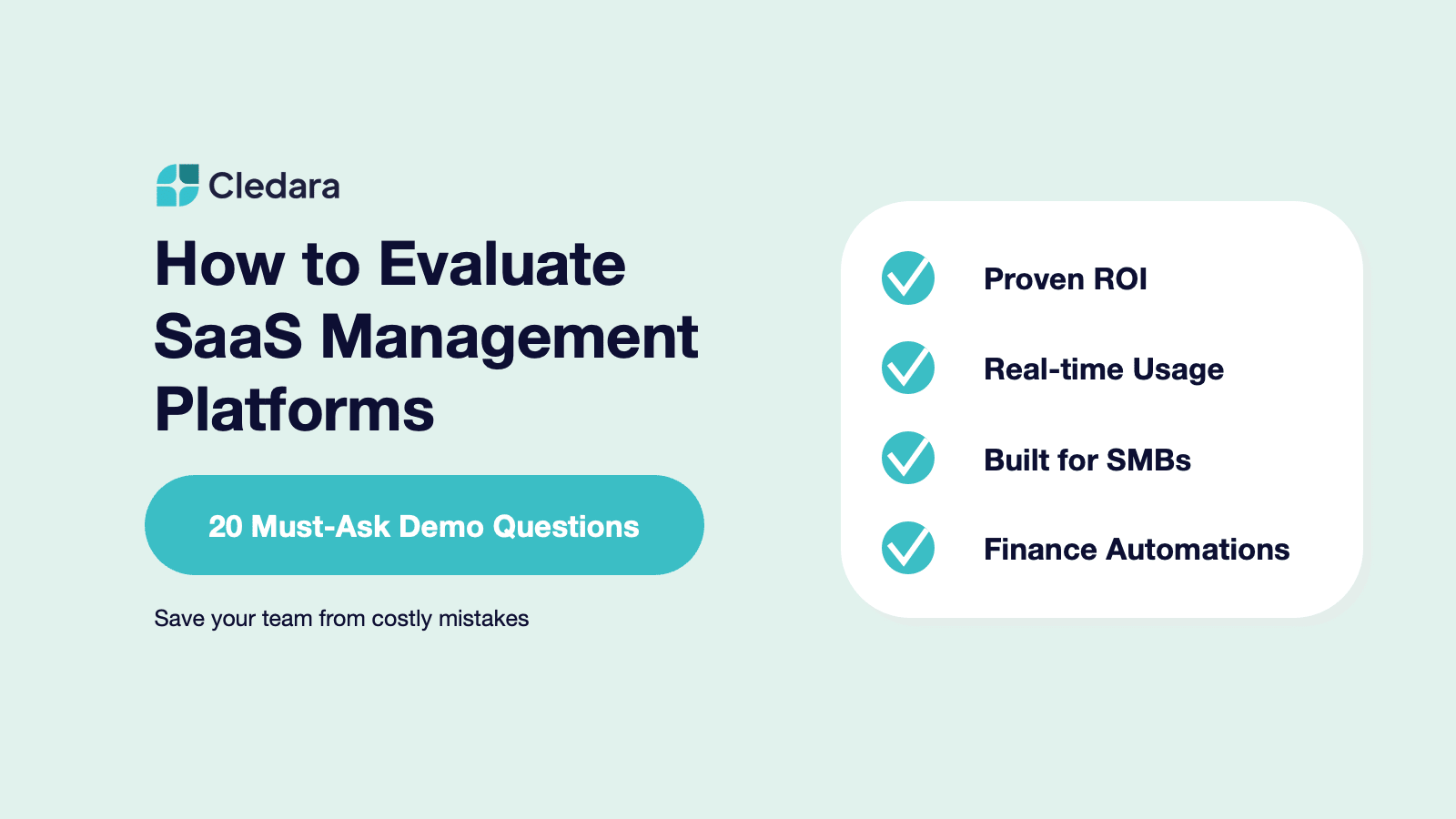By entering your email you agree to the Privacy Policy and consent to receive emails from Cledara.
Procurement is the strategic process of selecting, acquiring, monitoring, and evaluating an asset for a company. Meanwhile, purchasing simply means buying an asset. In purchasing, there may be prior research, but there is no detailed follow-up as in the procurement process.
SaaS Procurement Step by Step**
SaaS procurement is a comprehensive process that encompasses the entire lifecycle of a SaaS tool within a company. It entails various stages, starting with identifying the need for the tool and extending all the way to the potential cancellation of the subscription.
The steps of the SaaS procurement process include:
- Identify the need
- Assess the options
- Choose a vendor
- Negotiate a contract
- Implement the solution
- Review the solution's performance
- Decide on renewal
Let us go over each one in detail.
Identify the Need
The first step is to identify a need. To do this, you should:
- Be in permanent contact with your teams - Engaging in continuous conversations with team members and leaders allows you to discover new needs that may emerge. It is crucial to not only focus on specific concerns but also observe potential patterns. By doing so, you can determine whether a particular tool is necessary for a specific need or if an all-in-one solution can address multiple concerns across departments.
- Know their processes in detail - There may be tasks that can be feasibly automated or improved, but they need to be identified. Team members are typically focused on their own tasks and may not have the time or energy to have a broader perspective on their processes. Hence, understanding their workflows is essential to effectively supporting and streamlining their work, ultimately making their job easier.
- Be mindful - Not everything can be solved with a SaaS tool. Sometimes the solution lies elsewhere, such as by hiring specialists, reducing bottlenecks, or documenting processes.
In order to identify team needs, you can have regular meetings with them, conduct interviews with the leaders, or observe them on a common working day.
Assess the Options
Once you have identified your company’s needs and decided that a SaaS solution can help, it’s time to evaluate your options and determine the specific type of tool that can be of assistance. Let’s say that your team has collaboration frictions. Will a project management tool be the best solution? Would an internal communication tool suffice?
Since there are countless SaaS tools on the market, it is important to ensure the new tool:
- Doesn’t have overlapping features with other tools in your current stack
- Solves the problem in its entirety
- Meets the size and budget of your company
- Has an easy learning curve
- Provides good technical support
Choose a Vendor
Just as there are many types of SaaS tools on the market, there are also many vendors. In fact, different vendors may offer similar solutions.
When choosing a provider, consider the following:
- Reputation
- Customer support quality
- Adherence to security standards
- Compliance with regulations
It's crucial to have a reliable vendor when subscribing to a SaaS tool. This is not only to ensure seamless service and support but also to safeguard your data security and your clients' information.
Negotiate Your Contract
Once you have selected the right supplier, it’s essential to prepare yourself for negotiating your subscription. After all, some subscriptions can cost thousands of dollars.
To be well-prepared for this stage, it is important to keep in mind:
- Budget behavior: Understand the budgetary constraints and financial behavior of your organization to negotiate a subscription that aligns with your budget.
- Number of licenses: Determine the exact number of licenses required to fulfill the needs of your team. This will help in negotiating the appropriate pricing and ensuring sufficient access for all users.
- Specific features: Have a clear understanding of the exact features and functionalities you need from the SaaS tool. Thus, you’ll negotiate a subscription that includes the necessary capabilities without paying for extras.
- Financial dynamics: Consider the financial dynamics of your organization, such as cash flow patterns and budgeting cycles. You can use this information to negotiate favorable payment terms and contract lengths that suit your financial situation.
Taking these considerations into account will assist you in negotiating a contract that meets the needs of your company. It will determine important aspects of the subscription, such as:
- Duration: Whether it is a monthly or yearly subscription
- Pricing model: Whether it is fixed or based on tool usage
- Feature set: The specific features included in the subscription
- Industry or geography factors: Whether there are any discounts or special terms based on industry or geographical location
Implement the Solution
Now, it’s time to proceed with the implementation of your selected SaaS tool. During this process, it is crucial to involve your IT team to manage user profiles and permissions effectively.
You must also teach teams how to use the tool so that it performs at its best. For this, it may be necessary to prepare a training program that includes tutorials, documentation, and support.
Review the SaaS Solution’s Performance
The tool has already been purchased and implemented. Yet, the procurement process doesn't end there. The truth is that you won’t know if the tool effectively fulfills your company’s needs until you see it in action over a period of time. Therefore, you should evaluate the tool’s performance.
We suggest that you:
- Establish deadlines for evaluation- it could be monthly, quarterly, or biannually; this will depend on your team’s needs. Considering that the SaaS tool is a recent acquisition, you may want to do it on a monthly basis during the initial months.
- Define clear performance metrics to objectively assess the tool's effectiveness.
- Pay attention to user feedback. While the tool may address the identified need, users may have concerns or dissatisfaction with the interface or usage dynamics.
Decide on Renewal
Your periodic evaluations should guide your decision on whether to renew or cancel your subscription. It’s essential to make a well-informed choice, as the addition or removal of a tool directly affects your teams' workflows and productivity. We suggest you consider the value, effectiveness, and alignment of the tool with your organization's needs and goals.
SaaS Procurement Challenges**
SaaS tools may seem like a solution to all problems, but they're not a silver bullet. They also bring their own set of challenges. You may encounter multiple hurdles throughout the procurement process; some of them include:
- Smooth team collaboration
- Procurement roles are new
- Integration management
- Measuring the performance of a SaaS solution
Let’s take a closer look.
Smooth Team Collaboration
In the procurement process, many teams play integral roles:
- Finance: They oversee the allocation and management of resources.
- IT: They are responsible for driving the necessary infrastructure to support the procurement and implementation of the SaaS tool, ensuring its seamless integration into existing systems.
- HR: They orchestrate personnel-related aspects of the procurement, such as assessing the tool's impact on employee workflows and facilitating any necessary training or onboarding processes.
- Compliance: They ensure that all applicable rules, regulations, and policies are followed throughout the procurement process, mitigating any potential risks and ensuring adherence to legal and ethical standards.
Achieving seamless collaboration among teams can be challenging, akin to solving a multifaceted puzzle. It involves merging diverse processes, objectives, and communication styles into a coordinated and streamlined operation.
Procurement Roles are New
The complexity and impact of the procurement process have paved the way for new teams and roles. So, new roles such as SaaS Procurement Manager are emerging within many companies.
Nevertheless, even if you don't have a dedicated procurement team, someone within your company is handling those responsibilities. So, it’s worth considering: Should you have a dedicated role or team specifically for this task?
The decision may depend on factors such as the size of your organization and the extent of your SaaS requirements. While the emergence of these new roles reflects the evolving business landscape, integrating them should not be taken lightly. It requires careful consideration as it has the potential to redefine resource allocation and workflows. Ultimately, it could contribute to your overall success in a strategic manner.
Integration Management
Introducing a new SaaS tool brings complexities in terms of deployment and integration with the existing software stack. Each SaaS tool has its own architecture, structure, and requirements. So it can be a challenge to blend it seamlessly into the existing pile of software. It's more than just a technological consideration; it's a strategic imperative. The integration process has the potential to significantly impact operational efficiency and user satisfaction.
Measure the Performance of the SaaS Solution
As with any business initiative, it is crucial to monitor the performance and effectiveness of the new tool.
Some KPIs you should track include:
- Time to value- This metric tracks the time it takes for a user to start deriving value from the SaaS tool.
- Active users - The number of people actively using the tool can provide insights into user adoption and acceptance
- Active departments- The number of departments using the tool.
- Usage metrics- This metric lets you know if the tool is used enough or underutilized.
- Monthly and annual costs- The expenses associated with the tool.
By tracking SaaS performance, you can make sure you’re investing in tools that deliver ROI to your business.
3 SaaS Procurement Best Practices**
The SaaS procurement process can be lengthy and complex, but you can streamline it by implementing some best practices:
- Leverage free trials
- Negotiate the right subscription
- Focus on ROI
Leverage Free Trials
Free trials are a great way to explore the features of a new SaaS before making a financial commitment. It serves to:
- Determine if the product aligns with the company's needs
- Evaluate its compatibility with existing systems and workflows
- Gauge the effectiveness of the vendor’s customer support
Moreover, through consistent use during the trial period, you can gather preliminary performance metrics that can significantly contribute to your decision-making.
Negotiate the Right Subscription
SaaS plans and packages vary in their offerings and features, and not all of them will meet your specific needs. By negotiating with vendors, you can request a customized plan. This ensures that you are not overpaying for unnecessary features or underpaying and missing out on vital ones.
Subscription negotiation allows for scalability as your business grows and evolves. By negotiating the right agreement, you can ensure flexibility to upscale or downscale as necessary.
Indeed, negotiating the right SaaS subscription is not solely about the services you're procuring. It also involves understanding the various opportunities for savings that can optimize your investment, like:
- Discounts for particular industries - such as education, public sector, startups, and nonprofit organizations
- Geographical discounts - enabling companies in developing regions to access reduced rates
- Bulk discounts - SaaS providers often provide significant discounts for purchasing a large number of licenses
Mind About ROI**
Companies often subscribe to SaaS tools without considering the return on investment (ROI) they can provide. This can lead to bloated tech stacks and unnecessary expenses. Plus, poorly performing tools also consume time and resources that could be better allocated elsewhere.
It’s crucial to focus on the ROI of a SaaS tool. This will offer tangible evidence of its value in terms of profit and cost savings.
Calculating ROI involves considering the total cost of the tool and the financial benefits derived from it. The specific metrics used to measure ROI may vary depending on the company's objectives, but they are an essential part of the procurement process.
Calculating ROI involves looking at:
- The total cost of the SaaS tool (including all costs such as subscriptions, implementation, hardware, and training)
- The direct and indirect financial benefits derived from it (KPIs)
The specific metrics used to measure ROI may vary depending on the company's objectives, but they are an essential part of the procurement process.
Enhance SaaS Procurement With Cledara**
As we've seen, SaaS procurement is a lengthy and complex process. Performance metrics play a pivotal role in deciding whether to retain or cancel a subscription, and measuring these can indeed present a challenge. That's where Cledara steps in.
Cledara is the only SaaS management platform that allows you to:
- Obtain performance metrics of all your SaaS subscriptions
- Keep track of all your tools in one place
- Identify savings opportunities and optimize software spend
- Facilitate cooperation between Finance, IT, and Procurement teams
- Assign and revoke licenses with ease
- Spot unnecessary subscriptions and unsubscribe with one click
- Ensure compliance with procurement policies
- Have a single place to manage vendor contracts, payments, and software subscriptions
- Prevent shadow IT
Curious? Book a Cledara demo today.

.webp)
















.webp)

%2520(1).webp)